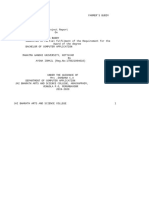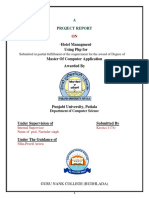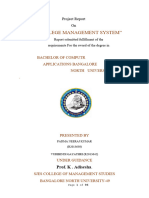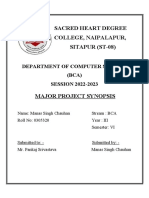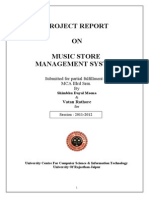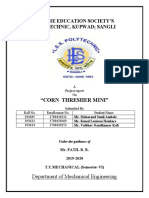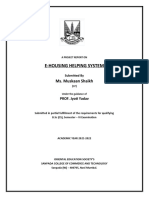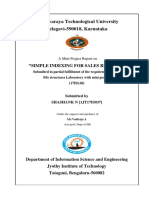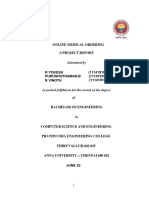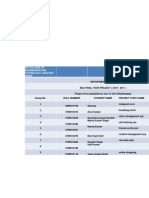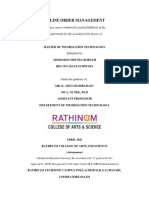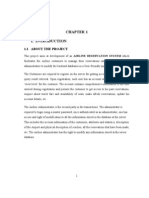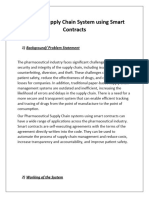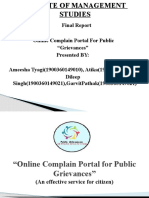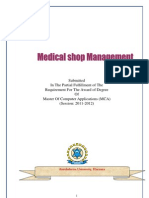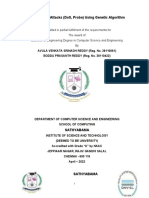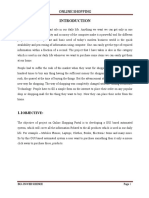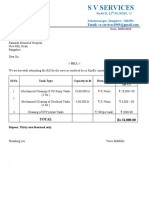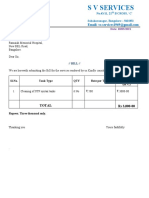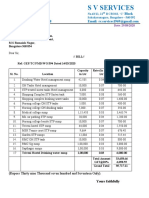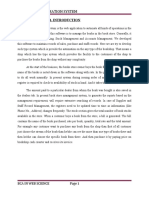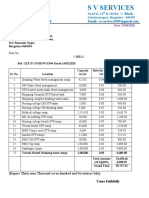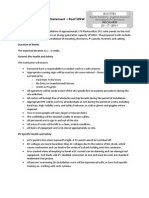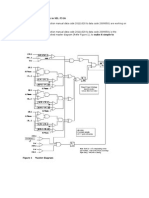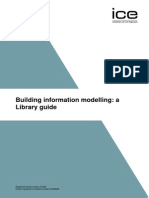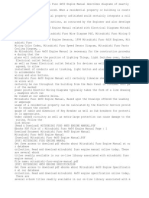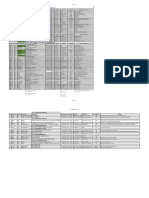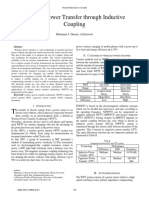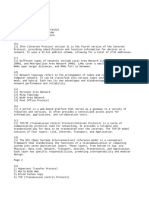Farmers' Digital Aid
Uploaded by
The Tech ExpertFarmers' Digital Aid
Uploaded by
The Tech ExpertFARMERS BUDDY
1. INTRODUCTION
This is a web based project which is useful for farmers. This is an open discussion portal
providing solutions to small farmers. It also provides soil analysis for all regions and
suggestions on which fertilizers to use where and how much? And which crop, herb or
vegetable to be grown where and in which season? It also helps to make decisions on market
and best prices. Information about major crop markets and their current price for the crop will
be published daily. NGO’s are trying to spread messages to make agriculture more eco-
friendly through this site. This also includes training scheduled by agricultural officers.
Training is requested by students, general public. Training provides information about crops,
fertilizers, and market details that are requested. Online query handlings for all users. Queries
can be posted by general public through mails. Queries can be directed to a particular officer.
Information pages should be dynamic so that agricultural officers and administrator can
change it.
1.1 OBJECTIVE
It is an open discussion portal used for agricultural students and farmers. Any general
public can use this system for knowing the information about various crops, and the usage of
fertilizers to those crops and in which soil these crops give more yield and the climatic
conditions for those crops.
Training is requested by the students, general public. These trainings are scheduled by
agricultural officer. Information about major crop markets and their current price for the crop
will be published daily.
Current prices of the markets are updated daily by the NGO. It gives information
regarding all the states in India.
BCA IN WEB SCIENCE Page 1
FARMERS BUDDY
2. EXISTING SYSTEM
Complexity in managing the data related to the agriculture products, soils, fertilizers, market
details. Farmers face the problems when they wanted to know the details about season to
farm which crop in which soil. How much and which fertilizers to use they don’t know.
DISADVANTAGES:
Lack of security.
This system does not provide category wise classifications of products.
Inefficiency in querying details.
Periodic Report generation takes lot of time.
BCA IN WEB SCIENCE Page 2
FARMERS BUDDY
3. PROPOSED SYSTEM
The development of this new system contains the following activities, which try to automate
the entire process keeping in the view of database integration approach.
Reduce complexity in managing the data related to the agriculture products, soils,
fertilizers, market details.
Current system provides different access levels for security.
Rich user interface is provided in order to interact with application.
Reports are generated dynamically on a periodic basis.
Equipment are available for farmers to buy.
Efficiency in querying details.
User Queries and Answers are maintained.
Whether details will be sent to registered mobile number.
BCA IN WEB SCIENCE Page 3
FARMERS BUDDY
4. SOFTWARE & HARDWARE REQUIREMENTS
4.1 SOFTWARE REQUIREMENTS:
• Front End : HTML,CSS,HTML
• Middle Ware : PHP
• Back End : MYSQL
• Server : XAMPP
• Connector : PHP , MYSQL
• Coding purpose : Notepad++
• Browser : Google Chrome ,Internet Explorer ,Mozilla Firefox
4.2 HARDWARE REQUIREMENTS:
• Processor : Pentium IV or above
• RAM : 256 MB and above
• Hard Disk : 5 GB HDD or above
• Mouse : Standard Mouse
• Keyboard : Standard Keyboard
BCA IN WEB SCIENCE Page 4
FARMERS BUDDY
5. INTRODUCTION TO PHP & MYSQL
5.1 PHP
PHP is a popular high-level scripting language used by a range of organizations and
developers. Originally developed as a small Perl project by Rasmus Lerdorf in late 1995,
PHP was intended as a means to assist in developing his home page, and as such he named it
Personal Home Page (PHP) Tools.
When Lerdorf was contracted to work for the University of Toronto to build adial-up system
for students to access the Internet, he had no means of connecting Web sites to databases. To
solve this problem, the enterprising Lerdorf replaced his Perl code with a C wrapper that
added the capability to connect his Web pages to a MySQL database. As his small project
grew, he gave away his changes on the Internet as an Open Source project and cordially
received improvements from other programmers with an interest in PHP. The language was
later renamed to the current recursive acronym PHP: Hypertext Pre-processor by Zeev
Suraski and Andi Gutmans after they rewrote the parser in 1997. The software continued to
develop and now forms the comprehensive PHP platform we know today.
PHP provides a solid and well-defined programming language that includes support for
object orientated programming, conditions, file handling, arithmetic, and more. The language
that PHP forms is similar in semantics to that of a shell scripting language combined with the
easier bits of the C language. PHP subscribes to the batteries-included philosophy of
programming languages and includes extensive support for a huge range of needs, such as
cookies, forms, sessions, include files, network sockets, e-mail and more. Database support
covers not only MySQL but many others, including but not limited to Posture SQL, Oracle,
MS SQL, dBase, Sybase, and DB2. This flexible database support is useful if you ever need
to port your application to a different database. In addition to PHP’s capability as a Web
scripting language, PHP also can be used as a shell scripting language.
XAMPP provides a complete PHP, Apache, and MySQL Web development environment that
can be installed by downloading, unzipping, and running the software. XAMPP makes the
installation dramatically easier, and the software also includes a raft of additions and extras
that are genuinely useful, including PHP extensions, a Web front end for MySQL (which is
used throughout the book), and more. XAMPP is freely available for Windows, Linux, Mac
OS X, and Solaris.
Vision provides cost-effective and customizable PHP Web Programming Services in order to
render a range of PHP Web Development Services for both new and existing websites
BCA IN WEB SCIENCE Page 5
FARMERS BUDDY
running on PHP / Apache/ MySQL combination which is becoming the choice of IT and non-
IT industry leaders for dynamic websites
Oceanic Vision leads the world market as a quality PHP Outsourcing Company in India
through the development of PHP based websites and fast driven applications. Oceanic Vision
provides timely, efficient and affordable PHP Programming Services. We have gained
experience through a variety of PHP Projects done for customers based in India
History
The first version of PHP, PHP/FI, was developed by Rasmus Lerdorf as a means of
monitoring page views for his online resume’s and slowly started making a mark in mid-
1995. This version of PHP had support for some basic functions, primarily the capability to
handle form data and support for the mSQL database. PHP/FI 1.0 was followed by PHP/FI
2.0 and, in turn, quickly supplanted in 1997 by PHP 3.0.
PHP 3.0, developed by Andi Gutmans and Zeev Suraski, was where things started to get
interesting. PHP 3.0 was a complete rewrite of the original PHP/FI implementation and it
included support for a wider range of databases, including MySQL and Oracle. PHP 3.0’s
extensible architecture encouraged independent developers to begin creating their own
language extensions, which served to increase the language’s popularity in the developer
community. Before long, PHP3.0 was installed on hundreds of thousands of web servers, and
more and more people were using it to build database-backed web applications.
PHP 4.0, which was released in 2003, used a new engine to deliver better performance,
greater reliability and scalability, support for web servers other than Apache, and a host of
new language features, including built-in session management and better OOP support. And,
as if that wasn’t enough, the current tversion of PHP, PHP 5.0, offers a completely revamped
object model that uses object handles for more consistent behaviour when passing objects
around, as well as abstract classes, destructors, multiple interfaces, and class type hints.
PHP5.0 also includes better exception handling, a more consistent XML toolkit, improved
MySQL support, and a better memory manager. So far, all these changes have conspired to
make PHP 5.0 the best PHP release in the language’s ten-year history . . . a fact amply
illustrated by the April 2004 Netcraft survey, which shows PHP in use on over fifteen million
web sites.
BCA IN WEB SCIENCE Page 6
FARMERS BUDDY
Features
As a programming language for the Web, PHP is hard to ignore. Clean syntax, object-
oriented fundamentals, an extensible architecture that encourages innovation, support for both
current and upcoming technologies and protocols, and excellent database integration are just
some of the reasons for the popularity it currently enjoys in the developer community.
• Simplicity
Because PHP uses a consistent and logical syntax, and because it comes witha clearly written
manual, even novices find it easy to learn. In fact, the quickest way to learn PHP is to step
through the manual’s introductory tutorial, and then start looking at code samples off the
Web. Within a few hours, you’ll have learned the basics and will be confident enough to
begin writing your own scripts. This adherence to the KISS (Keep It Simple, Stupid)
principle has made PHP popular as a prototyping and rapid application development tool for
web applications. PHP can even access C
libraries and take advantage of program code written for this language, and the language is
renowned for the tremendous flexibility it allows programmers in accomplishing specific
tasks.
• Portability
With programming languages, portability—the ease with which a program can be made to
work on different platforms—is an important factor. PHP users have little to fear here,
because crossplatform development has been an important design goal of PHP since PHP 3.0.
Today, PHP is available for a wide variety of platforms, including UNIX, Microsoft
Windows, Mac OS, and OS/2. Additionally, because PHP code is interpreted and not
compiled, PHP scripts written on one platform usually work as is on any other platform for
which an interpreter exists. This means that developers can code on Windows and deploy on
UNIX without any major difficulties.
• Speed
Out of the box, PHP scripts run faster than most other scripting languages, with numerous
independent benchmarks putting the language ahead of competing alternatives like JSP,
ASP.NET, and Perl. When PHP 4.0 was first released, it raised the performance bar with its
completely new parsing engine. PHP 5.0 improves performance even further through the use
of an optimized memory manager, and the use of object handles that reduce memory
consumption and help applications run faster.
BCA IN WEB SCIENCE Page 7
FARMERS BUDDY
• Open Source
Possibly the best thing about PHP is that it’s free—its source code is freely available on the
Web, and developers can install and use it without paying licensing fees or investing in
expensive hardware or software. Using PHP can thus significantly reduce the development
costs of a software application, without compromising on either reliability or performance.
The open-source approach also ensures faster bug fixes and quicker integration of new
technologies into the core language, simply due to the much larger base of involved
developers.
• Extensible
Keeping future growth in mind, PHP’s creators built an extensible architecture that enables
developers to easily add support for new technologies to the language through modular
extensions. This extensibility keeps PHP fresh and always at the cutting edge of new
technology. To illustrate this, consider what PHP lets youdo through its add-on modules:
dynamically create image, PDF, and SWF files; connect to IMAP and POP3 servers;
interface with MySQL, Oracle, Postgre SQL, and SQLite databases; handle electronic
payments; parse XML documents; and execute Perl, Java, and COM code through a PHP
script. And as if all that wasn’t enough, there’s also an online repository of free PHP classes
called PEAR, the PHP Extension and Application Repository, which provides a source of
reusable, bug-free PHP components.
• XML and Database Support
Regardless of whether your web application sources its data from an XML fileor a database,
PHP has you covered. PHP 5.0 comes with an improved MySQL extension that enables you
to take advantage of new features in the MySQL RDBMS (including subqueries, transactions,
and referential integrity), and the language also supports DB2, Postgre SQL, Oracle, mySQL,
MS-SQL, Informix, Sybase, and SQLite. Alternatively, if it’s XML you’re after, PHP 5.0
offers a completely redesigned XML API built around the libxml2 toolkit; this API supports
SAX, DOM, and XSLT, as well as the new Simple XML and SOAP extensions.
BCA IN WEB SCIENCE Page 8
FARMERS BUDDY
5.2 MySQL
MySQL is a high-performance, multiuser relational database management system that is
today the de facto standard for database-driven software applications, both on and off the
Web. Designed around three fundamental principles—speed, stability, and ease of use—and
freely available under the GNU General Public License, MySQL has been dubbed “the
world’s most popular open-source database” by its parent company. And with good reason.
Official statistics reveal over five million sites are creating, using, and deploying MySQL-
based applications, with more coming into the fold on a daily basis.
If you are planning on starting, for example, a bank or a savings and loan, MySQL probably
isn’t for you. But for the majority of people using the majority of applications, MySQL is a
great choice. It is particularly well suited for Web applications.
MySQL is a powerful and comprehensive relational database server, which was originally
developed by David Axmark, Allan Larsson, and Michael “Monty” Widenius. The
commercial company they founded, MySQL AB, develops and markets MySQL and
associated products. Although the MySQL software originated as an Open Source project, its
creators were confident that they could run a business using the product as a base. This
business enables the developers to work full time on the software, which in turn benefits both
the Open Source community and commercial users of MySQL. Both the open and
commercial MySQL variants are functionally the same; the only difference in the software is
how it is licensed.
MySQL also has support for a number of programming languages to access and query the
database. This includes languages such as PHP, Python, Perl, C, C++, and Java, among
others. Although you may wish to initially use only PHP to query the database,
Multilanguage support is useful if you need to write modules and applications in different
languages in the future.
BCA IN WEB SCIENCE Page 9
FARMERS BUDDY
History
The MySQL story hasn’t always been about rocketing growth rates and high user satisfaction
ratings, however. MySQL has an interesting history, with roots going back to 1979, when
Michael “Monty” Widenius created a database system named UNIREG for the Swedish
company TcX. UNIREG didn’t work for TcX on account of performance issues, and so TcX
began a search for alternatives. They tried mySQL, a competing DBMS created by David
Hughes, but when that attempt also failed, a new approach was called for. Thus, Widenius
decided to create a new database server customized to his specific requirements, but based on
the mySQL API (to simplify porting applications between the two). That system, completed
and released to a small group in May 1996, became MySQL 1.0.
A few months later, MySQL 3.11 saw its first public release as a binary distribution for
Solaris. Linux source and binaries followed shortly; an enthusiastic developer community and
a friendly, GPL-based licensing policy took care of the rest. As MySQL grew in popularity,
TcX became MySQL AB, a private company that today is the sole owner of the MySQL
server source code and trademark. MySQL AB is responsible for maintenance, marketing,
and further development of the MySQL database server and related products. Today, MySQL
is available for a wide variety of platforms, including Linux, MacOS, and Windows.
Features
MySQL’s development history has always been characterized by a clear-eyed focus on the
most important attributes of a good RDBMS: speed and stability. This has resulted in a
system that outperforms most of its competitors without sacrificing reliability or ease of use,
thereby gaining it a loyal base of developers, administrators, and users worldwide. The
following sections describe MySQL’s most compelling features.
• Speed
In an RDBMS, speed—the time taken to execute a query and return the results to the caller—
is everything. MySQL scores high on this parameter, with better performance than almost all
its
BCA IN WEB SCIENCE Page 10
FARMERS BUDDY
competitors, including commercial systems like Microsoft SQL Server and IBM DB2. This
blazing performance is more the result of intelligent software design than luck: MySQL uses
a fully multithreaded architecture; special optimizers for complex tasks like joins and
indexing; a query cache, which improves performance without any special programming
needed by the user; and the capability to use different storage engines on a per-table basis, so
that users can mix and match different feature sets to squeeze the maximum performance out
of the system.
• Reliability
When it comes to reliability, MySQL’s creds are impeccable. The MySQL RDBMS has been
tested and certified for use in high-volume, mission-critical applications by some of the
world’s largest organizations, including NASA, HP, and Yahoo! Because MySQL has deep
roots in the open-source community, every new release is typically “battle-tested” by users all
over the world, on different operating systems and in different operating conditions, to ensure
that itis completely bug-free before being certified for use. Further, every new release of
MySQL first has to pass MySQL’s in-house test suite, affectionately known as crash-me
because its primary goal is to attempt to crash the system.
• Security
Security is an important concern when dealing with multiuser databases, and MySQL’s
developers have taken a great deal of care to ensure that MySQL is as secure as possible.
MySQL comes with a sophisticated access control and privilege system to prevent
unauthorized users from accessing the system. This system, implemented as a five-tiered
privilege hierarchy, enables MySQL administrators to protect access to sensitive data using a
combination of user- and host-based authentication schemes. Users can be restricted to
performing operations only on specified databases or fields, and MySQL even makes it
possible to control which types of queries a user can run, at database, table, or field level.
BCA IN WEB SCIENCE Page 11
FARMERS BUDDY
• Scalability and Portability
MySQL can handle extremely large and complex databases without too much of a drop in
performance. Tables of several gigabytes containing hundreds of thousands of records are not
uncommon, and the MySQL web site itself claims to use databases containing 50 million
records.
And once you’ve got your tables filled with data ,you can move them from one platform to
another without any difficulty—MySQL is available for both UNIX and non-UNIX operating
systems, including Linux, Solaris, FreeBSD, OS/2, MacOS, and Windows 95, 98, Me, 2000,
XP, and NT. It runs on a range of architectures, including Intel x86, Alpha, SPARC,
PowerPC, and IA64, and supports many different hardware configurations, from low-end
386s to high-end Pentium machines.
• Ease of Use
Most commercial RDBMSs are intimidating, with cryptic command-line interfaces and
hundreds of tunable parameters. Not this one, though—well aware that a complex interface
adds to the total cost of ownership of an RDBMS, the MySQL development team has taken
pains to make MySQL easy to use, administer, and optimize. A simple SQL command-line
interface (SQL commands are covered in Chapters 9 to 11) is the primary user interface to the
server; users with a more visual bent can, instead, use MySQL Control Center or MySQL
Administrator, two GUI clients developed by MySQL AB for MySQL usage and
administration. A number of other browser-based tools are also available, and the application
is well supported by a detailed manual, a knowledgeable developer community, and some
excellent books and tutorials.
• Compliance with Existing Standards
MySQL 4.0 supports most of the important features of the ANSI SQL-99 standard, with
support for missing features slated to be added in future versions. MySQL also extends the
ANSI standard with its own custom functions and data types designed to improve portability
and provide users with enhanced functionality. On the internationalization front, MySQL 4.0
BCA IN WEB SCIENCE Page 12
FARMERS BUDDY
supports a number of important character sets (including Latin, Big5, and European character
sets), with full Unicode support scheduled for future versions.
• Wide Application Support
MySQL exposes APIs to many different programming languages, thereby making it possible
to write database-driven applications in the language of your choice. This book focuses
specifically on using PHP with MySQL, but readers working with other programming
languages will be pleased to hear that MySQL AB also provides native ODBC and JDBC
drivers for the Microsoft Windows and Java platforms. Additionally, hooks to MySQL are
available in C, C++, Perl, Python, and Tcl, to offer developers maximum freedom in
designing MySQL-backed applications.
• Easy Licensing Policy
The MySQL RDBMS is licensed under the GPL, and users are free to download and modify
the source code of the application to their needs, and to use it to power their applications free
of cost. This licensing policy has only fuelled MySQL’s popularity, creating an active and
enthusiastic global community of MySQL developers and users. This community plays an
active role in keeping MySQL anahead of its competition, both by crash-testing the software
for reliability on millions of installations worldwide and by extending the core engine to stay
abreast of the latest technologies and newest developments.
BCA IN WEB SCIENCE Page 13
FARMERS BUDDY
5.3 APPLICATION ARCHITECTURE
In information systems, applications architecture or application architecture is one of several
architecture domains that form the pillars of an enterprise architecture (EA).
Applications architecture describes the behavior of applications used in a business, focused
on how they interact with each other and with users. It is focused on the data consumed and
produced by applications rather than their internal structure. In application portfolio
management, the applications are usually mapped to business functions and to application.
The applications architecture is specified on the basis of business and functional
requirements. This involves defining the interaction between application packages, databases,
and middleware systems in terms of functional coverage. This helps identify any integration
problems or gaps in functional coverage. A migration plan can then be drawn up for systems
which are at the end of the software life cycle or which have inherent technological risks.
Applications architecture tries to ensure the suite of applications being used by an
organization to create the composite architecture is scalable, reliable, available and
manageable. Applications architecture means managing how multiple applications are poised
to work together. It is different from software architecture, which deals with technical designs
of how a system is built.
One not only needs to understand and manage the dynamics of the functionalities the
composite architecture is implementing but also help formulate the deployment strategy and
keep an eye out for technological risks that could jeopardize the growth and/or operations of
the organization.
• Application modelling
Employs modelling as a framework for the development of new or enhanced applications,
uses modelling to find problems, reduce risk, improve predictability, reduce cost and time-to-
market, tests various product scenarios, incorporating clients' needs/requirements, adds test
design decisions to the development process as necessary, evaluates product design problems.
BCA IN WEB SCIENCE Page 14
FARMERS BUDDY
Competitive intelligence, business modelling, strategic analysis understanding of the global
marketplace, consumers, industries and competition, and how global business models,
strategies, finances, operations and structures interrelate. Understanding of the competitive
environment, including current trend in the market, industry, competition and regulatory
environment, as well as understanding of how the components of business model (i.e.
strategy, finances, operations) interrelate to make organization competitive in the
marketplace. Understanding of organization's business processes, systems, tools, regulations
and structure and how they interrelate to provide products and services that create value for
customers, consumers and key stakeholders. Understanding of how the value create for
customers, consumers and key stakeholders aligns with organization's vision, business,
culture, value proposition, brand promise and strategic imperatives. Understanding of
organization's past and present achievements and shortcomings to assess strengths,
weaknesses, opportunities and risks in relation to the competitive environment.
• Technology
Understanding of IT strategy, development lifecycle and application/infrastructure
maintenance; Understanding of IT service and support processes to promote competitive
advantage, create efficiencies and add value to the business.
• Technology standards
Demonstrates a thorough understanding of the key technologies which form the infrastructure
necessary to effectively support existing and future business requirements, ensures that all
hardware and software comply with baseline requirements and standards before being
integrated into the business environment, understands and is able to develop technical
standards and procedures to facilitate the use of new technologies, develops useful guidelines
for using and applying new technologies.
BCA IN WEB SCIENCE Page 15
FARMERS BUDDY
6. FEASIBILITY STUDY
It is both necessary and prudent to evaluate the feasibility of a project at the earliest possible time. Months or
years of effort, thousands and millions of dollars, and untold professional embarrassment can be averted if an ill-
conceived system is recognized early in the definition phase. Feasibility and risk analysis are related in many
ways. If project risk is great, the feasibility of producing quality software is reduced. During product
engineering, however, we concentrate our attention on four primary areas of interest.
6.1 ECONOMICAL FEASIBILITY
The company already possesses the required hardware and software. There is no investment
in hardware and software. The benefits of installing the application lie in the speedy
processing of data, faster retrieval of information and increasing volume of data, and all these
with greater accuracy and consistency. To sum up, the benefits are great and cost is minimal.
Therefore, the project is economically feasible.
Economic Feasibility in this project:
• The cost to conduct a full system investigation is possible.
• There is no additional manpower requirement.
• There is no additional cost involved in maintaining the proposed system.
6.2 TECHNICAL FEASIBILITY
The current system has Personal Computers. All the works are done on Word Processor and
spread sheets. The company already possesses the required software. In the current working
system , it requires time to produce the reports. We have to find out whether the necessary
technology, the proposed equipment have the capacity to hold the data, which is used in the
project, should be checked to carry out this technical feasibility. The response time is high for
processing queries. This will lead to high demands on the available technical resources and
demands being placed on the clients.
BCA IN WEB SCIENCE Page 16
FARMERS BUDDY
6.3 PERFORMANCE FEASIBILITY
The system is expected to work smoothly when developed and installed. There has been
participation of management and the computer operators in planning and development of the
system. There will be a slight change in the format of the reports to which management
agreed. There is no disturbance in organizational structure of the company. The new
application for the system will have Graphical User Interfaces (GUI). The applications with
GUI are very easy to handle and operate. The company has to train their staff members which
can easily done in one or two days. They need to be instructed regarding using of the
application software.
Operational feasibility in this project:
• The proposed system offers greater level of user friendliness.
• The proposed system produces best results and gives needful information.
• It can be implemented easily.
• So this project is operationally feasible.
BCA IN WEB SCIENCE Page 17
FARMERS BUDDY
7. DESIGN OBJECTIVE
7.1 DATA FLOW DIAGRAM:
7.1.1 LEVEL 0:
Processing the
Request for crop 0.0 request and
FARMER details in MARKET
sending
market DETAILS
FARMERS details
BUDDY
Response Response
BCA IN WEB SCIENCE Page 18
FARMERS BUDDY
7.1.2 LEVEL 1:
Request for PROCESSING
crop details
1.0
CROP
ADMIN
FARMER DETAILS
S in
market
CROP DB
RESPOND
2.0
VIEWING ALL
THE CROP
DEATILS
3.0
PROCESSING
UPDATE
THE CROP
FARMERS DB
DETAILS
BCA IN WEB SCIENCE Page 19
FARMERS BUDDY
7.1.3 ER DIAGRAM:
FARMER
ID
NAME
ADMIN
MOBILE NAME ID
NO
1 1
FARMER CROP ADMIN
1
1
MOBILE
STATE NO
PINCODE
USES
NAME
N N
COST CROP
FERTILIZERS DETAILS
MARKET DETAILS
TYPE
CROP
DESC
PRICE FERTILIZER
DETAILS
BCA IN WEB SCIENCE Page 20
FARMERS BUDDY
8. DATA TABLE
8.1 LOGIN PROFILE
ATTRBUTES DATA TYPE CONSTRAINTS
Login id Varchar2(40) Primary key
City Varchar2(40) Not Null
State Varchar2(40) Not Null
Country Varchar2(40) Not Null
email Varchar2(25) Not Null
BCA IN WEB SCIENCE Page 21
FARMERS BUDDY
8.2 LOGIN DETAILS
ATTRBUTES DATA TYPE CONSTRAINTS
Login name Varchar2(30) Primary key
Password Varchar2(30) Not Null
Login type Varchar2(20) Not Null
First name Varchar2(40) Not Null
Last name Varchar2(40) Not Null
Login status Int(20) Not Null
BCA IN WEB SCIENCE Page 22
FARMERS BUDDY
8.3 FERTILIZER
ATTRBUTES DATA TYPE CONSTRAINTS
Nitrogen Int(20) Not Null
Phosphor Int(20) Not Null
Crops name Varchar2(30) Not Null
Soil name Varchar2(20) Not Null
BCA IN WEB SCIENCE Page 23
FARMERS BUDDY
8.4 MAILS
ATTRBUTES DATA TYPE CONSTRAINTS
Message id Int(20) Not Null
From name Varchar2(20) Not Null
To name Varchar2(20) Not Null
Send date date Not Null
subject Varchar2(30) Not Null
message Varchar2(100) Not Null
8.5 MARKET DETAILS
ATTRBUTES CONSTRAINTS DATA TYPE
State code Int(20) Not Null
Dist code Int(20) Not Null
Market id Int(20) Not Null
market Varchar2(30) Not Null
BCA IN WEB SCIENCE Page 24
FARMERS BUDDY
8.6 MARKET REPORT
ATTRBUTES CONSTRAINTS DATA TYPE
Market Int(20) Primary key
Variety Int(20) Not Null
grade Varchar2(20) Not Null
Min price Int(20) Not Null
Max price Int(20) Not Null
Unit price Varchar2(30) Not Null
Id Int(20) Not Null
8.7 BLOG
ATTRBUTES CONSTRAINTS DATA TYPE
Posted by Varchar2(20) Not Null
Post date date Not Null
Status Varchar2(10) Not Null
BCA IN WEB SCIENCE Page 25
FARMERS BUDDY
8.8 CROPS:
ATTRBUTES CONSTRAINTS DATA TYPE
Soil name Varchar2(40) Not Null
Crop name Varchar2(20) Not Null
Season Varchar2(20) Not Null
8.9 STATE INFO
ATTRBUTES CONSTRAINTS DATA TYPE
State code Int(20) Primary key
State Varchar2(40) Not Null
BCA IN WEB SCIENCE Page 26
FARMERS BUDDY
9. MODULE DESCRIPTION
9.1 Admin
Admin is the one who can add the details about market, crop, season. Admin has the
rights to see the details of framers and the id , password.
9.2 FARMER
First, to enter this system the users has to login to this system. Farmers has restricted
access. i.e., Normal users have access to some of the modules only.
9.3 FERTILIZERS
This module is used to maintain the various Fertilizers Details. This module will be
enabled only to the admin type of users.
This module contains:
A separate screen should be provided to maintain the Fertilizers Details. It
should provide a way to add, modify and delete the both details.
If a new Soil Information is received it should be added to the System.
If a new Fertilizer information is received it should be added to the system
with the corresponding details like soil name, crop type, crop name etc.
BCA IN WEB SCIENCE Page 27
FARMERS BUDDY
9.4 MARKET DETAILS
In this module we can maintain the market details. This module will be enabled only to
the admin type of users.
This module contains:
A separate screen should be provided to maintain the market related
information. It should provide a way to add, modify and delete the market
related information.
Administrator type of user can add the commodities in the market.
He can add the information about new markets into the system.
He can add the market report into the system regarding a particular market and
commodities prices details in that market in a day.
BCA IN WEB SCIENCE Page 28
FARMERS BUDDY
10. TEST CASES
10.1 Test scenario for admin login
Test scenario for admin id: Username
Test case description: Login positive test case
Pre-Requisite: A valid admin dashboard
Test Case ID: 101
sl Action Inputs Expected Actual Test Test
no. Output Output Result Comments
Launch the localhost/farmersbuddy Farmers Farmers Pass Login
1. application buddy buddy successful
property home
home page
page
Enter the Username: admin Login Login Pass Login
2. correct Password: xxxx successful successful successful
username
and
password
and hit the
login
button
BCA IN WEB SCIENCE Page 29
FARMERS BUDDY
10.2 Test scenario for admin login with password
Test scenario for admin id: Username
Test case description: Login negative test case
Pre-Requisite: A invalid admin dashboard
Test Case ID: 102
sl no. Action Inputs Expected Actual Test Test
Output Output Result Comments
Enter invalid Username: The The Fail Invalid
1. username and property username username login
any password Password: that you that you attempt
and hit the xxxxx have have stopped
login button entered is entered is
wrong wrong
enter again enter again
? ?
Enter the Username: Password Password Fail Invalid
2. valid admin you have you have login
username and Password: entered is entered is attempt
incorrect xxx incorrect incorrect stopped
password and
hit the login
button
BCA IN WEB SCIENCE Page 30
FARMERS BUDDY
10.3 Test scenario for Add Product
Test scenario for Adding product
Test case description: Register positive test case
Pre-Requisite: A valid Add property home page
Test Case ID: 103
sl Action Inputs Expected Actual Test Test
no. Output Output Result Comments
Open Localhost/ Add Add Pass Add
1. market farmersbuddy/admin/ product product Property
page and Market/add product page will page will page open
add open we open we successfully
product. can add can add
product. product.
Enter the Title: crop Details Details Pass Add
2. details title, Type: vegetable you have you have Product
type, sold, Description: good entered is entered is successfully
price, for health correct correct
Farmer, Image: (upload) and based and based
description, on on
image. category category
product product
will be will be
displayed. displayed.
BCA IN WEB SCIENCE Page 31
FARMERS BUDDY
10.4 Test scenario for Add Product
Test scenario for Adding product
Test case description: Register negative test case
Pre-Requisite: A invalid Add product home page
Test Case ID: 104
sl Action Inputs Expected Actual Test Test
no. Output Output Result Comments
Enter the Title: crop Details Details Fail Add Product
1. details title, Type: vegetable you have you have unsuccessfully
type, sold, Description: good entered is entered is
price, for health incorrect incorrect
Farmer, Image: (upload) try again. try again.
description,
image.
BCA IN WEB SCIENCE Page 32
FARMERS BUDDY
10.5 Test scenario for Registration of farmer
Test scenario for Registration
Test case description: Registration positive test case
Pre-Requisite: A valid Registration
Test Case ID: 105
sl Action Inputs Expected Actual Test Test
no. Output Output Result Comments
Open Localhost/farmers Register Register Pass Register
1. registration buddy/ Register page will page will successful
page and be opened be opened
enter the and and
details customer customer
can register can register
fill their fill their
details details
Enter the farmer name: sahan Details Details Pass Register
2. valid details Address: HSR what we what we successful
and fill the Layout City: have have
form for Bangalore Email ID: entered is entered is
register sahan@gmail.com correct and correct and
Mobile:956825634 2 customer customer
Gender: Male Birth has been has been
Date: 2208-1995 registered registered
Username: sarat
Password: yyyyyy
BCA IN WEB SCIENCE Page 33
FARMERS BUDDY
10.6 Test scenario for Registration of farmer
Test scenario for Registration
Test case description: Registration negative test case
Pre-Requisite: A invalid Registration
Test Case ID: 106
sl Action Inputs Expected Actual Test Test
no. Output Output Result Comments
Enter the User Name:sarat Register Register Fail Register
1. user name , Mobile:9090807069 page will page will unsuccessful
mobile is Email ID: show a show a
valid but the abcd@gmail.com message as message as
email id is please please
incorrect enter valid enter valid
email email
Enter the User Name:sarat Register Register Fail Register
2. user name Mobile:907069 Email page will page will unsuccessful
is valid but ID: abcd@gmail.com show a show a
the mobile message as message as
number is please please
incorrect enter valid enter valid
mobile mobile
number number
BCA IN WEB SCIENCE Page 34
FARMERS BUDDY
11. REPORT GENERATION
11.1 HOME PAGE
In this Home Page we can see the details about the page which is placed on the website. In
the home page we can see the login on the right side of the home page in that username ,
password and choose the user type and click on login.
BCA IN WEB SCIENCE Page 35
FARMERS BUDDY
11.2 LOGIN PAGE
Admin and farmer can login as, User Name: admin, Password: admin and then click on Login
button. Even user can login here after he register himself in registration form is submitted.
Then he can login as User Name: ABC, Password: xxx and choose the login type and click on
Login button.
BCA IN WEB SCIENCE Page 36
FARMERS BUDDY
11.3 REGISRARTION PAGE
There is a Registration page in this website where the user can register and can fill their
like,CompanyName,Contactperson,Address,City,EmailID,MobileNumber,UserName,Passwo
rd And Click on Submit User will be registered.
BCA IN WEB SCIENCE Page 37
FARMERS BUDDY
11.4 MARKET PAGE
In this page you will see the profile to add the product or to buy the product
BCA IN WEB SCIENCE Page 38
FARMERS BUDDY
11.5 PRODUCT PAGE
In this you will see the various product from various farmers with the price, you can buy them by
selecting a product.
BCA IN WEB SCIENCE Page 39
FARMERS BUDDY
11.6 PROFILE PAGE
This is the profile of the user’s they can change password or any other details related to them.
BCA IN WEB SCIENCE Page 40
FARMERS BUDDY
11.7 BLOG PAGE
Here farmer or the admin can write a blog about the product.
BCA IN WEB SCIENCE Page 41
FARMERS BUDDY
12. CONCLUSION
It is not possible to develop a system that makes all the requirements of the user. User
requirements keep changing as the system is being used. Some of the future enhancements
that can be done to this system are as the technology emerges it is possible to upgrade the
system and can be adaptable to desired environment. Because it is based on object-oriented
design, any further changes can be easily adaptable. Based on the future security issues,
security can be improved using emerging technologies. Case Registration module can be
added. By this project, we provide various information regarding soil, crops, fertilizes for
farmers. It also solves various queries posted by the users. It makes agriculture more eco-
friendly.
BCA IN WEB SCIENCE Page 42
FARMERS BUDDY
13. FUTURE SCOPE
It is not possible to develop a system that makes all the requirements of the user. User
requirements keep changing as the system is being used. Some of the future enhancements
that can be done to this system are:
As the technology emerges, it is possible to upgrade the system and can be adaptable
to desired environment.
Because it is based on object-oriented design, any further changes can be easily
adaptable.
Based on the future security issues, security can be improved using emerging
technologies.
Case Registration module can be added
BCA IN WEB SCIENCE Page 43
FARMERS BUDDY
BIBLIOGRAPHY:
1. PHP & MySQL Novice to Ninja – by Kevin Yank
2. Head First PHP & MySQL – by Lynn Beighley & Michael Morrison
3. www.agricultureindia.com
BCA IN WEB SCIENCE Page 44
You might also like
- Guidelines For Project Work For BCA 6TH Semester 2023-24No ratings yetGuidelines For Project Work For BCA 6TH Semester 2023-246 pages
- A PROJECT REPORT ON Hotel Managment UsinNo ratings yetA PROJECT REPORT ON Hotel Managment Usin137 pages
- (Vaccine Management System) : Bachelor of Computer ApplicationsNo ratings yet(Vaccine Management System) : Bachelor of Computer Applications69 pages
- Project Report On Music Store Management System: Submitted For Partial Fulfillment of Mca Iiird Sem. by100% (2)Project Report On Music Store Management System: Submitted For Partial Fulfillment of Mca Iiird Sem. by102 pages
- AUTOMATIC AGE AND GENDER DETECTION MCA - DocumentesNo ratings yetAUTOMATIC AGE AND GENDER DETECTION MCA - Documentes68 pages
- A Project Report: Submitted in Partial Fulfillment For The Award of The Degree ofNo ratings yetA Project Report: Submitted in Partial Fulfillment For The Award of The Degree of71 pages
- E-Housing Helping System: Ms. Muskaan ShaikhNo ratings yetE-Housing Helping System: Ms. Muskaan Shaikh26 pages
- Iec-College of Engineering and Technology, Greater NoidaNo ratings yetIec-College of Engineering and Technology, Greater Noida1 page
- Train Reservation System Document - Docx - 20250126 - 193645 - 0000100% (1)Train Reservation System Document - Docx - 20250126 - 193645 - 000030 pages
- Atulkumar Bca 5thsem A35404819038 NTCC Amity University JharkhandNo ratings yetAtulkumar Bca 5thsem A35404819038 NTCC Amity University Jharkhand76 pages
- Engineering Students' Food Ordering SystemNo ratings yetEngineering Students' Food Ordering System15 pages
- Online Evaluation System: Project Report OnNo ratings yetOnline Evaluation System: Project Report On49 pages
- Project - 7 - Cyber Cafe Management SystemNo ratings yetProject - 7 - Cyber Cafe Management System32 pages
- Online Musical Instrumental Store Management System Project ReportNo ratings yetOnline Musical Instrumental Store Management System Project Report64 pages
- Project Report (Online Growskills Platform)No ratings yetProject Report (Online Growskills Platform)26 pages
- Pharma Supply Chain System Using Smart Contracts: 1) Background/ Problem StatementNo ratings yetPharma Supply Chain System Using Smart Contracts: 1) Background/ Problem Statement11 pages
- Email Client Application Implementing SMTP and POP - DOCNo ratings yetEmail Client Application Implementing SMTP and POP - DOC103 pages
- University Mangament System Using Artificial IntelligenceNo ratings yetUniversity Mangament System Using Artificial Intelligence14 pages
- Insurance Management System: A Project Report On "No ratings yetInsurance Management System: A Project Report On "37 pages
- "Online Shopping": A Project Report Submitted byNo ratings yet"Online Shopping": A Project Report Submitted by1 page
- "Online Shopping": A Project Report Submitted byNo ratings yet"Online Shopping": A Project Report Submitted by1 page
- "Online Book Shop": A Project Report Submitted byNo ratings yet"Online Book Shop": A Project Report Submitted by1 page
- Certificate: Signature of The Guide In-Charge Signature of The ExaminerNo ratings yetCertificate: Signature of The Guide In-Charge Signature of The Examiner1 page
- Tank Clean: Block PH: 9741990089 / 8147539128No ratings yetTank Clean: Block PH: 9741990089 / 81475391281 page
- "Online Book Shop": A Project Report Submitted byNo ratings yet"Online Book Shop": A Project Report Submitted by1 page
- Certificate: Charan Singh R Bearing RegisterNo ratings yetCertificate: Charan Singh R Bearing Register1 page
- Tank Clean: Block PH: 9741990089 / 8147539128No ratings yetTank Clean: Block PH: 9741990089 / 81475391281 page
- Tank Clean: To, M/s Gokula Education Foundation, M S Ramaiah Nagar, Bangalore - 560 054No ratings yetTank Clean: To, M/s Gokula Education Foundation, M S Ramaiah Nagar, Bangalore - 560 0541 page
- Deploying The Best Model in A Few Minutes With Bentoml and MlflowNo ratings yetDeploying The Best Model in A Few Minutes With Bentoml and Mlflow11 pages
- Item PWS6600C-N / AP1600C-N PWS6600C-P / AP1600C-P PWS6600C-S / AP1600C-SNo ratings yetItem PWS6600C-N / AP1600C-N PWS6600C-P / AP1600C-P PWS6600C-S / AP1600C-S3 pages
- Master of Information Technology and Systems (973AA)No ratings yetMaster of Information Technology and Systems (973AA)4 pages
- Wireless Power Transfer Through Inductive Coupling: Mohamed A. Hassan, A.ElzawawiNo ratings yetWireless Power Transfer Through Inductive Coupling: Mohamed A. Hassan, A.Elzawawi4 pages
